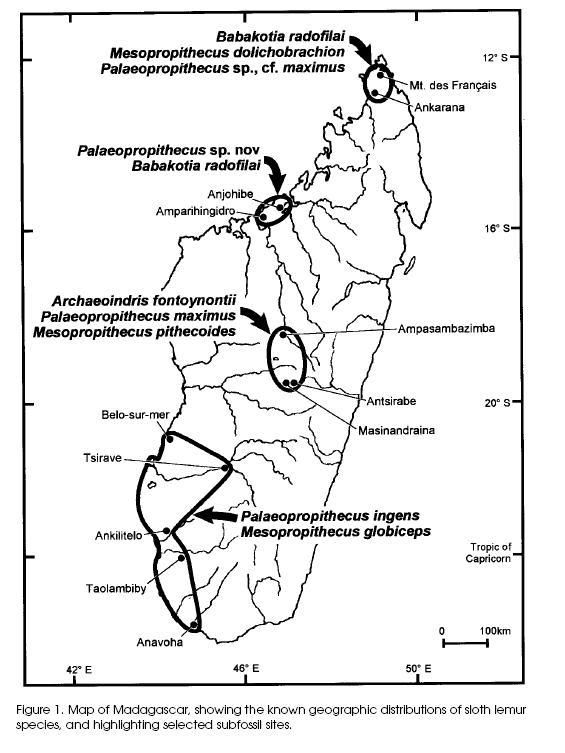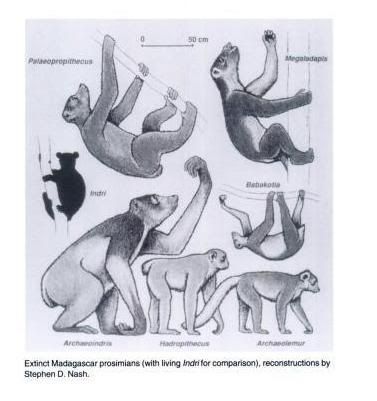|
|
Post by Melanie on Jun 4, 2005 6:34:41 GMT
Mesopropithecus pithecoides
TAXONOMY:
suborder: Strepsirrhini
infraorder: Lemuriformes
superfamily: Lemuroidea
family: Indriidae
MORPHOLOGY:
Mesopropithecus pithecoides had relatively large upper incisors (Fleagle, 1988). This species had a dental formula of 2:1:2:3 on the upper jaw and 2:0:2:3 on the lower jaw (Martin, 1990). The skeleton of this species was more robust than members of the extant genus Propithecus (Fleagle, 1988). The humerus and the femur of this species were about the same size (Fleagle, 1988). This species had an average body mass of around 11.0 kilograms (Fleagle, 1988).
RANGE:
Mesopropithecus pithecoides was found on the island of Madagascar (Fleagle, 1988).
DIET:
Based upon dental morphology this was a folivorous species (Fleagle, 1988).
LOCOMOTION:
Based upon postcranial remains this species was most likely an arboreal quadruped (Jungers, 1980; cited in Fleagle, 1988).
REFERENCES:
Fleagle, J.G. 1988. Primate Adaptation and Evolution. Academic Press: New York.
Jungers, W.L. 1980. Adaptive Diversity in Subfossil Malagasy Prosimians. Z. Morphol. Anthropol., Vol. 71(2), 177-186.
Martin, R.D. 1990. Primate Origins and Evolution: A Phylogenetic Reconstruction. Princeton University Press: Princeton, New Jersey.
Last updated: November 14, 2001
|
|
|
|
Post by another specialist on Jun 4, 2005 7:41:08 GMT
|
|
|
|
Post by sordes on Feb 28, 2007 10:46:18 GMT
|
|
|
|
Post by another specialist on Feb 28, 2007 17:37:44 GMT
Mesopropithecus - Cranial Characteristics Mesopropithecus retains the indriid-type toothcomb with four anterior teeth and shares numerous dental features with indriids and other palaepropithecids, however it has larger upper incisors than the extant Propithecus. Mesopropithecus is also characterized by short upper and lower premolars. Mesopropithecus The smallest and most primitive of the palaeopropithecids, Mesopropithecus is the most similar subfossil lemur to extant indriids, especially Propithecus, and a basal member of the sloth lemurs. Of the palaeopropithecids, it was the most quadrupedal, engaging in loris-like slow climbing and quadrupedalism with some forelimb and hindlimb suspension. Geographical Distribution: central, northern, southern, and southwestern Madagascar Age: Late Quaternary Dental Formula: 2.1.2.3 / 2.0.2.3 Reconstructed Body Mass: 10 kg Diet: primarily folivorous, with some fruit and seeds Mesopropithecus - Dental Characteristics Mesopropithecus retains the indriid-type toothcomb with four anterior teeth and shares numerous dental features with indriids and other palaepropithecids, however it has larger upper incisors than the extant Propithecus. Mesopropithecus is also characterized by short upper and lower premolars. Mesopropithecus - Postcranial Characteristics As a basal member of the sloth lemurs, Mesopropithecus is the most indriid-like and quadrupedal, however it does share some suspensory adaptations with the other palaeopropithecids, including strongly curved proximal phalanges and moderately reduced spines of lumbar vertebrae. Like the indriids, Mesopropithecus has fore and hindlimbs equal in length. |
|
|
|
Post by another specialist on Mar 1, 2007 8:18:18 GMT
 bork.hampshire.edu/josiah/EVANarticle.pdf |
|
|
|
Post by another specialist on Jul 31, 2008 17:15:07 GMT
 Walker's Primates of the World By Ronald M. Nowak, Ernest Pillsbury Walker, Russell A. Mittermeier, William R. Konstant, Anthony B. Rylands |
|
|
|
Post by another specialist on Jul 31, 2008 17:21:04 GMT
 Walker's Primates of the World By Ronald M. Nowak, Ernest Pillsbury Walker, Russell A. Mittermeier, William R. Konstant, Anthony B. Rylands |
|
|
|
Post by Sebbe on Nov 8, 2024 15:41:51 GMT
|
|
|
|
Post by Sebbe on Nov 8, 2024 16:20:55 GMT
Who Ate the Subfossil Lemurs? A Taphonomic and Community Study of Raptor, Crocodylian and Carnivoran Predation of the Extinct Quaternary Lemurs of Madagascar.protectedareas.mg/document/show/269191
|
|